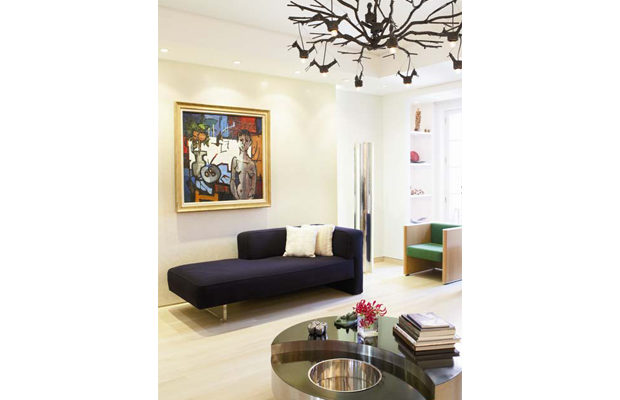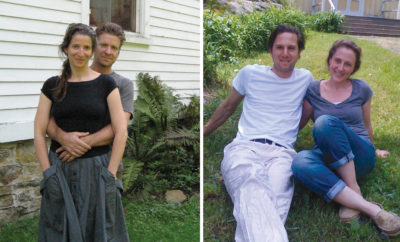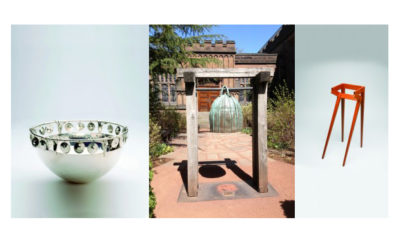
Feature
West Side Story

A coffee table by Willy Rizzo stands in the center of the living room, which also features a Vladimir Kagan Omnibus sofa and an armchair by Norman Foster. The iron ceiling fixture is from the French lighting designer Laurent Chauvat. The painting is Claude Vénard’s Interior with Still Life and Female Nude.
“Even when I’m at the movies, I look at the furniture,” confesses Adriana Friedman, who, as director of the always-extraordinary New York design gallery DeLorenzo, spends a great deal of time looking at superb furniture and other excellent objects. She was introduced to design at the age of twenty-two, and it was, she says “love at first sight.” A trip to Paris in the company of Tony DeLorenzo brought her to the works of Jean Prouvé, Serge Mouille, and Jean Royère, among others. There was no looking back. And that love grew and grew—to embrace the arts and crafts and art deco movements, American studio furniture, mid-century American work, contemporary design, as well as textiles, painting, and art pottery. Friedman not only sells design but also collects it and—along with her husband Jeffrey and daughter Arielle—lives with it.
Their spacious Upper West Side apartment occupies the top floors of a tall brick and limestone row house near the Hudson River. Originally five stories, now six, the building began life in 1901 as a private home, long since converted into apartments. The Friedmans, who met in 1993 and married the next year, bought it in 2000, then spent five years renovating and adapting. Their own residence occupies part of the third floor and all of the fourth and fifth as well as the sixth story, which they added. Jeffrey Friedman is an architect, developer, and contractor. “My husband is in charge of the architecture,” says Adriana emphatically. “And I am in charge of the design, the decorating.”
That natural order of things—Jeffrey on the architecture, Adriana on the design—has produced exquisite results. He kept and restored the building’s historic facade but let the interior spaces have a modern character with bleached white oak floors and woodwork, travertine, venetian plaster, and bronze and white-lacquer feature walls.
The apartment, though facing north and south, is light-filled and airy with spaces that seem to flow. Jeffrey sought to “create an open plan and bring in as much natural light as possible.” A skylight above the three-story staircase, he says, “brings sunlight down through the levels. On each floor there is a place where you can see from the front of the building all the way across to the back, and even to the outside, visually connecting the rooms of the house, and the interior spaces to the outdoor terraces. ”
You know that a deft architectural hand has been at work, but the architecture never dominates. Rather it yields to the quite extraordinary, yet discreet, furnishing of the house—with furniture, lighting, art, and objects that taken individually would seem singular and taken together really just seem like home—at least home for the Friedman family.

The Friedmans traveled to Pennsylvania to select the wood that Mira Nakashima used for their dining table. A Serge Mouille ceiling fixture hangs above the table, which is set with a Tiffany Studios bronze candelabra and a Puiforcat tea service. Vénard’s painting Vase de Fleurs was originally in Kirk Douglas’s home. The sculpture is Abstract Composition no. 2 by Albert Féraud.
Each piece in the house has a connection, a meaning. For example, the dining room table and chairs were made by Mira Nakashima. The Friedmans traveled to New Hope, Pennsylvania, to the Nakashima Studio, where, Adriana says, “we picked out wood that Mira’s father [the legendary craftsman George Nakashima] had worked on.” The table they commissioned is walnut with black rosewood butterfly ties and the chairs are black walnut. It is all very personal. For Adriana design is a lifelong love affair, and each piece she selects is more than wood, metal, clay, fiber, and fabric. “It has a presence, it has a vocabulary, it has a story to tell,” she says.
The furniture runs from craftsman to contemporary, showing Adriana’s broad palette and wide-ranging knowledge. In the historical continuum, the oldest pieces are likely to be the arts and crafts furniture in the couple’s bedroom, which includes a bed and side table as well as a dresser, reclining armchair, and floor lamp by L. and J. G. Stickley dating to the early decades of the twentieth century. Yet there are also such current pieces as a Laurent Chauvat light fixture and a Norman Foster armchair in the living room. Most of it splits the difference (of decades), however.
Adriana’s knowledge of the design world is carefully gained. She was working in the fashion industry when she was introduced to design. “I’ve been lucky to have had the best of the best as mentors,” she says. For the last three decades, more really, she has learned at the feet of the erudite and widely respected Tony DeLorenzo, whose midtown gallery she now runs and whom she regards as a visionary. “He has generously passed on his knowledge, helping me to refine my eye and encouraging me to be courageous when buying. Courage is one of the most important factors when collecting.” (Another important mentor was the collector Michael Chow, whom she also met in the 1980s. “He had the best pieces of art deco made by the top designers of the French deco period. I remember gasping out of amazement when I walked into his apartment,” she says.)

A bird cage sculpture by André Bloch stands in a corner.
From those early years at DeLorenzo, Adriana not only learned in depth about design but has gone on to make her mark as both a dealer and a collector. “I get a great deal of joy out of buying and selling, as well as helping to put together collections, collaborate with museums and living with these works of art,” she says, adding: “It is a privilege to be surrounded by these works of art, but it is also a responsibility—one that no dealer or collector should take lightly. After all, once we are gone, these pieces will live on. It is a fascinating learning experience, one that has defined who I am today.”
Indeed, the choice pieces that fill the house reflect a high level of intellectual sophistication, but they come together in a seamless way. The Vladimir Kagan sofa is for sitting as is the Tecno lounge chair. Likewise the kitchen—Jeffrey Friedman opted to keep it all white—is for cooking. He wanted the architecture to be as neutral as possible. The furniture comes from Knoll and is, says Adriana, “very typical—Eero Saarinen, Marcel Breuer.”
Elsewhere in the house, color abounds. The living room furniture features red, green, and blue upholstery. Arielle’s bedroom not only has a red Jonathan Singleton Easy Number One armchair but a multihued Verner Panton Flowerpot light fixture. “I love color,” says Adriana. Her collection of art pottery—it is divided equally between American art pottery and mid-century Capron pottery from France—adds more color. “And if I had more room, I’d collect even more of it,” she says.

On the terrace are an Isamu Noguchi Pierced table and Wind Catcher sculpture, and a Maria Pergay Ring chair.
A key architectural intervention was the addition of the sixth floor, which includes both an open and an enclosed terrace, giving the apartment the kind of connection to the outdoors that is a rarity in Manhattan. There’s a small kitchen terrace, as well as one off the master bedroom along with the two up top. Adriana has found a number of important pieces for the terraces, including a Pierced table and Wind Catcher sculpture by Isamu Noguchi and a Ring chair by Maria Pergay. Another of the terraces features Guy Lartigue’s sculpture Passage sans Niveau, standing alongside chairs and a table by the Italian mid-century designer Maurizio Tempestini and a white bench by the German designer Walter Papst.
The Friedmans use the terraces winter and summer alike. “In the winter, when there’s snow outside, it’s spare and very beautiful,” Adriana says. In the summer, the terraces—and the views from them—are green and lush. An added attraction is an opera singer who lives nearby and practices outdoors. “You’re having a cup of tea and the music wells up. It’s such a joy to hear it,” she says. “It’s all such a joy.”












